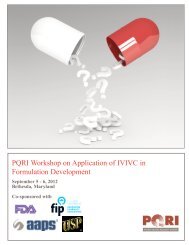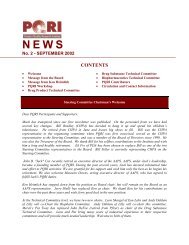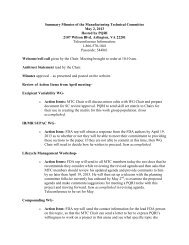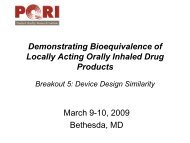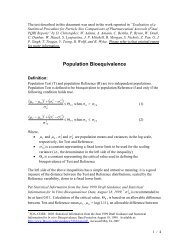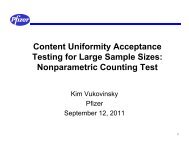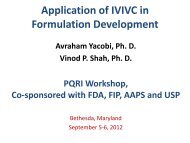Quality by Design for Orally Inhaled Drug Products - PQRI
Quality by Design for Orally Inhaled Drug Products - PQRI
Quality by Design for Orally Inhaled Drug Products - PQRI
You also want an ePaper? Increase the reach of your titles
YUMPU automatically turns print PDFs into web optimized ePapers that Google loves.
<strong>Quality</strong> <strong>by</strong> <strong>Design</strong> <strong>for</strong> <strong>Orally</strong> <strong>Inhaled</strong><strong>Drug</strong> <strong>Products</strong>Lawrence X. Yu, Ph.D.Director <strong>for</strong> ScienceOffice of Generic <strong>Drug</strong>sFood and <strong>Drug</strong> Administration<strong>PQRI</strong> Workshop on Demonstrating Bioequivalence of LocallyActing <strong>Orally</strong> <strong>Inhaled</strong> <strong>Drug</strong> <strong>Products</strong>, March 9-11, 2009Opinions expressed in this presentation are those of the speakersand do not necessarily reflect the views or policies of the FDA1
Credits• Sau Lee, Ph.D.• Robert Lionberger, Ph.D.• Wallace Adams, Ph.D.• Prasad Peri, Ph.D.• Bing Li, Ph.D.• Dale Conner, Pharm.D.2
What is Pharmaceutical <strong>Quality</strong>?• Janet Woodcock– Free of contamination and reproducibly delivering thetherapeutic benefit promised in the label to theconsumerPharmaceutical <strong>Quality</strong>= (<strong>Drug</strong> substance, excipients,manufacturing, and packaging)• <strong>Quality</strong> cannot be tested into products; quality canonly be built into products3
What is <strong>Quality</strong> <strong>by</strong> <strong>Design</strong>?• ICH Q8(R1)– The pharmaceutical <strong>Quality</strong> <strong>by</strong> <strong>Design</strong> (QbD) is asystematic approach to development that begins withpredefined objectives and emphasizes product andprocess understanding and process control, based onsound science and quality risk management• <strong>Quality</strong> <strong>by</strong> <strong>Design</strong> Tools– <strong>Design</strong> of experiments (DoE)– Risk assessment– Process analytical technology (PAT)4
What Constitutes QbD?Labeled UseSafety and EfficacyDEFINE <strong>Quality</strong>Target Product ProfileDESIGN Formulationand ProcessIDENTIFY Critical Material Attributesand Critical Process ParametersCONTROL Materialsand ProcessTARGET DESIGN IMPLEMENTATIONL. Yu. Pharm. Res. 25:781-791 (2008)5
<strong>Orally</strong> <strong>Inhaled</strong> <strong>Drug</strong> <strong>Products</strong>• Propellant driven metered dose inhalers(MDIs)• Dry powder inhalers (DPIs)• NebulizersMDIDPI (Advair Diskus)Nebulizer6
Dry Powder Inhalers• Contain micronized drug attached to largercarrier particles (i.e., lactose) or micronized drugparticles agglomerated into soft pellets• Employ the patient’s inspiratory ef<strong>for</strong>t to provideenergy <strong>for</strong> drug delivery (passive DPI system)Pre-metered SingleDose UnitPre-meteredMultiple Dose Unit<strong>Drug</strong> ReservoirHandihaler Diskus Twisthaler7
Why is QbD More Significant to<strong>Orally</strong> <strong>Inhaled</strong> <strong>Drug</strong> <strong>Products</strong>?• Inhalation manufacturing often exhibits lowprocess capability• Product is a device in association with a<strong>for</strong>mulation• Product handling may affect received dose• Environmental effects may influence productmanufacture and use• Low testing efficiency of aerodynamic particleassessment methods• Lack of clear in vitro - in vivo correlationsN. Bowles et al. <strong>Drug</strong> Delivery to the Lungs 18, The Aerosol Society, Edinburgh, UK, 2007:75-78 8
<strong>Quality</strong> Target Product Profile• A prospective summary of the qualitycharacteristics of a drug product that will bestensure the desired safety and efficacy.• Guide to establish <strong>for</strong>mulation strategy and keepthe <strong>for</strong>mulation ef<strong>for</strong>t focused and efficient9
What Does <strong>Quality</strong> Target ProductProfile Include?• Intended use in clinical setting– Route of administration, dosage <strong>for</strong>m (deliverysystem), and container closure system• <strong>Quality</strong> characteristics of drug product– Appearance, identity, strength, assay, uni<strong>for</strong>mity,purity/impurity, stability, and others• Active pharmaceutical ingredient release ordelivery and attributes affecting pharmacokineticcharacteristics (efficacy & safety)10
<strong>Quality</strong> Target Product Profile <strong>for</strong> DPIs• In vitro per<strong>for</strong>mance– Emitted dose– Aerodynamic particle size distribution– Delivered dose uni<strong>for</strong>mity• Product stability and purity• Patient usability/acceptability• Local and systemic delivery– Pharmacokinetic and pharmacodynamicmeasurements11
Formulation Considerations• Formulations of the currently approved DPIs– Micronized drug attached to larger carrierparticles (i.e., lactose) or– Micronized drug particles agglomerated into softpellets12
Formulation Considerations• Physicochemical properties of drug andexcipient(s) particles– Particle size and shape– Density– Surface properties– Solid (polymorphic) <strong>for</strong>m• Particle interactions– <strong>Drug</strong>-drug interactions– Excipient-excipient Interactions– <strong>Drug</strong>-excipient Interactions13
Device Considerations• Device resistance– Depends on the internal geometry anddimension– Influences achievable flow rates through thedeviceA.H. de Boer et al. Int. J. Pharm. 130: 231-244(1996)14
Device Considerations• Device materials– Understand the sources of extractables andleachables– Compatible with <strong>for</strong>mulation• Electrostatic effects between the device and drypowders• Patience usability– Device operation– <strong>Drug</strong> metering– Device resistance15
Development of Equivalent DPIs• Constraints <strong>for</strong> <strong>for</strong>mulation design– Q1 the same; Q2 the same preferred– Manufacturability• Constraints <strong>for</strong> device design– Similar shape– Equivalent design and operating principle– Comparable device resistance16
Process Development• Understand impact of material attributes andprocess parameters on product CQAs and thetarget quality profile• Identify critical process parameters and inputmaterial attributes that must be controlled toachieve product CQAs.• Use risk assessment to prioritize processparameters and material attributes <strong>for</strong>experiment verification• Combine prior knowledge with experiments toestablish a design space or other representationof process understanding17
Process Identification andUnderstanding: ConceptINPUTS(X)ProcessEquipmentMaterialY = ƒ(X)Priori knowledgeRisk Assessment<strong>Design</strong> ofExperimentsInputs to the processcontrol variabilityof the OutputYOUTPUTEnvironment18
<strong>Design</strong> Space• <strong>Design</strong> Space– The multidimensional combination and interaction ofinput variables (eg. material attributes) and processparameters that have been demonstrated to provideassurance of quality• Regulatory Implication– Movement out of the design space is considered tobe a change and would normally initiate aregulatory post-approval change process. <strong>Design</strong>space is proposed <strong>by</strong> the applicant and is subject toregulatory assessment and approval19
Delivered Dose Uni<strong>for</strong>mity• Delivered dose uni<strong>for</strong>mity– Within a container <strong>for</strong> multiple dose products– Between containers– Between batches• Delivered dose uni<strong>for</strong>mity testing documented inthe– FDA Metered Dose Inhaler (MDI) and Dry PowderInhaler (DPI) <strong>Drug</strong> <strong>Products</strong> - CMC Documentation(Draft, October 1998)– Nasal Spray and Inhalation Solution, Suspension, andSpray <strong>Drug</strong> <strong>Products</strong> - CMC Documentation (Final,July 2002)20
IPAC-RS (1998-2003)• Nonparametric limit tests– Counts the number of determinations in a samplewithin and outside certain pre-fixed limits• “NMT 1 of 9 determinations outside 80 - 120% of label claim• 0 outside 75 - 125% of label claim”• Too stringent to encompass all product types– High potential <strong>for</strong> failing good batches– OINDP cannot routinely meet expectations in draftGuidances, e.g., many products have been approvedwith exception to DDU tests acceptance criteria inpublished Guidanceshttp://www.fda.gov/ohrms/dockets/ac/03/slides/3996s1.htm21
2005 FDA Advisory Committee <strong>for</strong>Pharmaceutical Science Meeting• FDA presented a proposal <strong>for</strong> delivered doseuni<strong>for</strong>mity testing– Goalposts are 80% to 120% of label claim– 87.5% coverage within the goalposts• IPAC-RS– Implementation of PTI test in this manner results in acoverage requirement that is greater than the designpoint (95.8% <strong>for</strong> “10/10/30/30 - 87.5%” test)– Even higher coverage is required when the mean isoff targethttp://www.fda.gov/ohrms/dockets/ac/05/slides/2005-4187s1_Slide%20Index%20Day%201.htm22
2005 FDA ACPS Meeting Outcome• FDA emphasized a <strong>Quality</strong> <strong>by</strong> <strong>Design</strong>approach that calls <strong>for</strong> product andprocess understanding:– Clinical relevant specification– Understanding leads to good control ofvariability• IPAC-RS– The FDA October 4, 2005, proposal is tighterthan the 1998 MDI/DPI draft guidance test23
Cause Effect RelationshipArmanni et al. http://www.ipacrs.com/PDFs/Posters/RESP_On-screen%20version_IPAC2008%20Poster.pdf24
Control StrategiesLevel 1: Extensive end producttesting + Fixed Critical ProcessParameters (CPPs)Level 2: Reduced end product testing+ Flexible manufacturing processwithin fixed design spaceLevel 3: PAT, Real-time automatic“engineering control”+Flexible manufacturing processLevel ofControlLevel ofFreedomIncrease25
Level 1 ControlAPI, fixed particle sizeMCC, grade specifiedCroscarmellose NaMg stearate<strong>Drug</strong>productTestAppearanceIdentityAssayUni<strong>for</strong>mityImpuritiesTablet weightHardnessFriabilityDissolutionFixed order of additionFixed load levelFixed # of revolutionsBlendUni<strong>for</strong>mityTestingFixed pre-compression <strong>for</strong>ceFixed compression <strong>for</strong>ceFixed press speedFixed feeder speed26
Level 2 ControlWDS = Within <strong>Design</strong> SpaceAPI, particle size WDSMCC, particle size WDSCroscarmellose NaMg stearate<strong>Drug</strong>productTestAppearanceIdentityAssayUni<strong>for</strong>mityImpuritiesTablet weightHardnessFriabilityDissolutionFixed order of additionWDS load levelWDS # of revolutionsBlendUni<strong>for</strong>mityTestingWDS pre-compression <strong>for</strong>ceWDS compression <strong>for</strong>ceWDS press speedWDS feeder speedTesting may bereduced if predictedfrom input and processparameters27
Level 3 ControlUFC = Under Feedback ControlAPI, Flexible particle sizeMCC, Flexible particle sizeCroscarmellose NaMg stearate<strong>Drug</strong>productPAT“PAT”“” = …Flexible order of additionFlexible load levelUFC # of revolutionsUFC pre-compression <strong>for</strong>ceUFC compression <strong>for</strong>ceUFC press speedUFC feeder speed28
Control Variability• There is uncharacterized variability in theexcipients and process– Level 1 handles variability <strong>by</strong> excessivelytesting– Level 2 handles variability <strong>by</strong> limited testingand establishing design space <strong>for</strong> criticalmaterial attributes and process parameters– Level 3 is a robust process that can ensurequality in the presence of uncharacterizedvariability29
Conclusion• <strong>Quality</strong> <strong>by</strong> <strong>Design</strong>– is the basis <strong>for</strong> science-based regulatorydecisions– sponsors need to share PharmaceuticalDevelopment in<strong>for</strong>mation in the application• Generic Inhalation <strong>Products</strong>– Many opportunities to use QbD to developequivalent drug products30




